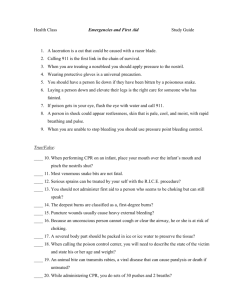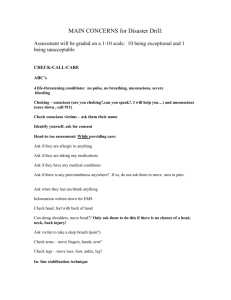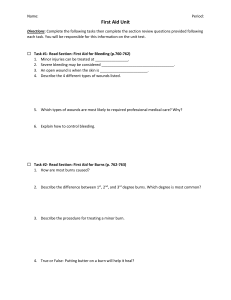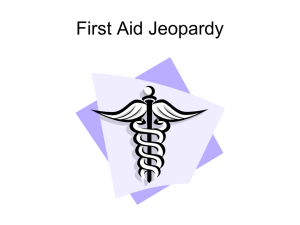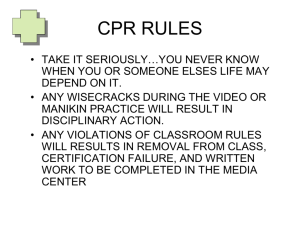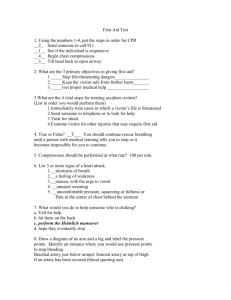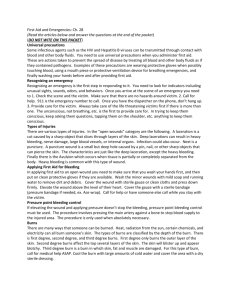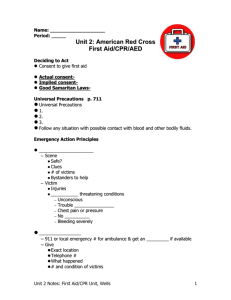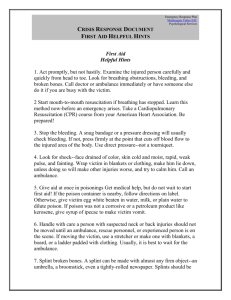Chapter 28 Test Form A
advertisement
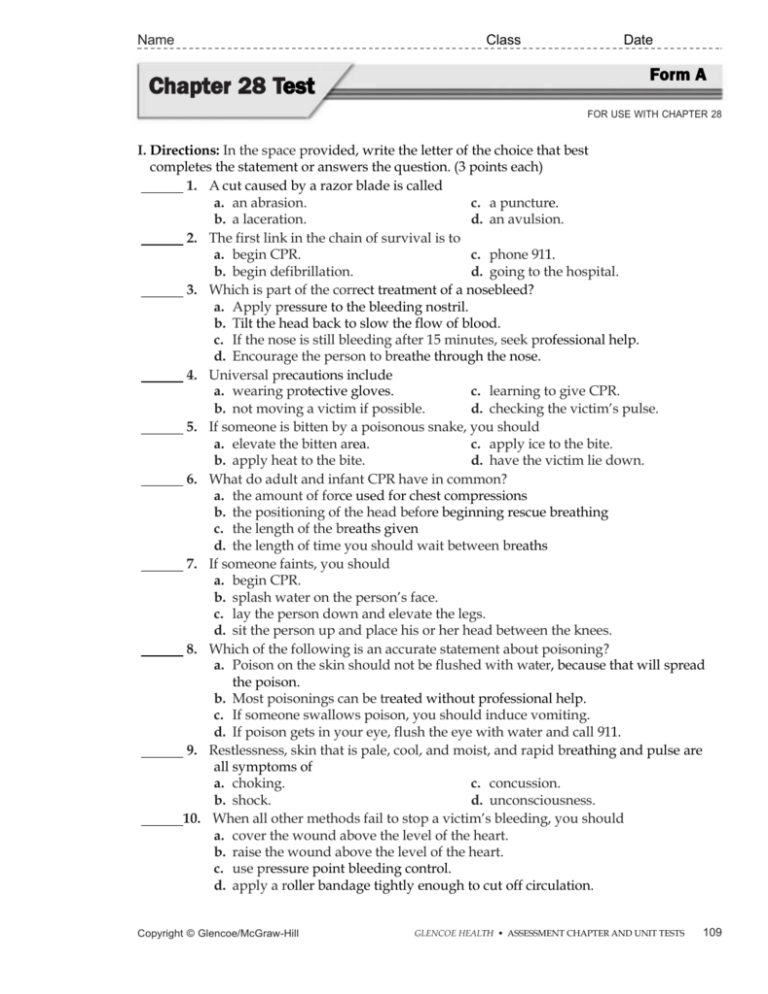
Name Chapter 28 Test Class Date Form A FOR USE WITH CHAPTER 28 I. Directions: In the space provided, write the letter of the choice that best completes the statement or answers the question. (3 points each) 1. A cut caused by a razor blade is called a. an abrasion. c. a puncture. b. a laceration. d. an avulsion. 2. The first link in the chain of survival is to a. begin CPR. c. phone 911. b. begin defibrillation. d. going to the hospital. 3. Which is part of the correct treatment of a nosebleed? a. Apply pressure to the bleeding nostril. b. Tilt the head back to slow the flow of blood. c. If the nose is still bleeding after 15 minutes, seek professional help. d. Encourage the person to breathe through the nose. 4. Universal precautions include a. wearing protective gloves. c. learning to give CPR. b. not moving a victim if possible. d. checking the victim’s pulse. 5. If someone is bitten by a poisonous snake, you should a. elevate the bitten area. c. apply ice to the bite. b. apply heat to the bite. d. have the victim lie down. 6. What do adult and infant CPR have in common? a. the amount of force used for chest compressions b. the positioning of the head before beginning rescue breathing c. the length of the breaths given d. the length of time you should wait between breaths 7. If someone faints, you should a. begin CPR. b. splash water on the person’s face. c. lay the person down and elevate the legs. d. sit the person up and place his or her head between the knees. 8. Which of the following is an accurate statement about poisoning? a. Poison on the skin should not be flushed with water, because that will spread the poison. b. Most poisonings can be treated without professional help. c. If someone swallows poison, you should induce vomiting. d. If poison gets in your eye, flush the eye with water and call 911. 9. Restlessness, skin that is pale, cool, and moist, and rapid breathing and pulse are all symptoms of a. choking. c. concussion. b. shock. d. unconsciousness. 10. When all other methods fail to stop a victim’s bleeding, you should a. cover the wound above the level of the heart. b. raise the wound above the level of the heart. c. use pressure point bleeding control. d. apply a roller bandage tightly enough to cut off circulation. Copyright © Glencoe/McGraw-Hill GLENCOE HEALTH • ASSESSMENT CHAPTER AND UNIT TESTS 109 Name Chapter 28 Test Class Date (Continued) FOR USE WITH CHAPTER 28 II. Directions: Place a plus (+) in the space provided if the statement is true. Place a zero (0) if the statement is false. (3 points each) 11. When performing CPR on an infant, place your mouth over the infant’s mouth and pinch the nostrils shut. 12. Most venomous snakebites are not fatal. 13. Serious sprains can be treated by yourself with the R.I.C.E. procedure. 14. You should not administer first aid to a person who seems to be choking but can still speak. 15. The deepest burns are classified as first-degree burns. 16. Puncture wounds usually cause heavy external bleeding. 17. Because an unconscious person cannot cough or clear the airway, he or she is at risk of choking. 18. A severed body part should be packed in ice or ice water to preserve the tissue. 19. When calling the poison control center, you will need to describe the state of the victim and state his or her age and weight. 20. An animal bite can transmit rabies, a viral disease that can cause paralysis or death if untreated. III. Directions: Match each term in the left column with the best definition in the right column. Write the letter of the best choice in the space provided. (3 points each) 21. venom a. a 24-hour hot line that provides emergency medical advice on treating poisoning victims 22. shock b. a break in the bone 23. poison c. a lifesaving first aid procedure that combines rescue 24. fracture breaths with chest compressions, supplying oxygen to 25. unconsciousness the body until normal body functions can resume 26. first aid d. a sequence of actions that maximize the victim’s chances 27. cardiopulmonary of survival resuscitation e. a failure of the cardiovascular system to keep an adequate (CPR) supply of blood circulating to the vital organs of the body f. any substance—solid, liquid, or gas—that causes injury, 28. concussion illness, or death when introduced into the body 29. chain of survival g. a poisonous substance secreted by a snake, spider, or 30. poison control other creature center h. a condition in which a person is not alert and aware of his or her surroundings i. the immediate, temporary care given to an ill or injured person until professional medical care can be provided j. a jarring injury to the brain, which affects normal brain function IV. Directions: Answer the following question on a sheet of paper. (10 points) 31. If you suddenly get something caught in your throat, what should you do?
